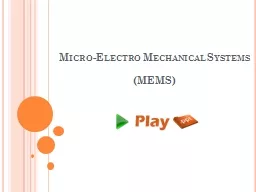

MEMS MEMS Micro Electrical Mechanical Systems Practice of making and combining miniaturized mechanical and electrical components Micromachines in Japan Microsystems Technology in Europe ID: 273278
Download Presentation The PPT/PDF document "Micro-Electro Mechanical Systems" is the property of its rightful owner. Permission is granted to download and print the materials on this web site for personal, non-commercial use only, and to display it on your personal computer provided you do not modify the materials and that you retain all copyright notices contained in the materials. By downloading content from our website, you accept the terms of this agreement.
Slide1
Micro-Electro Mechanical Systems (MEMS)Slide2
MEMS
Micro Electrical Mechanical Systems
Practice of making and combining miniaturized mechanical and electrical components“Micromachines” in Japan“Microsystems Technology” in EuropeSlide3
Outline
Introduction
Fabrication Technologies
Applications
Applications in defense department
Advantages and Disadvantages
Conclusions Slide4
Introduction
MicroElectroMechanical
is the technology of the very small, and merges at the nano-scale into nanoelectromechanical systems (NEMS)
MEMS based sensor products provide an interface that can sense, process and/or control the surrounding environment.
sensors are a class of devices that builds very small electrical and mechanical components on a single chip.
sensors are a crucial component in automotive electronics, medical equipment, hard disk drives, computer peripherals,wireless devices and smart portable electronics such as cell phones and PDAs.Slide5
FABRICATION TECHNOLOGIESMiniaturization Multiplicity Microelectronics Slide6
APPLICATIONS OF MEMSPressure sensorAccelerometers Inertial Sensors Microengines Slide7
MEMS technology creates personal navigation device for defense department Guidance and navigation have been critical for military success since the dawn of civilization.
Accuracy was the focus of earlier Department of Defense (DoD) navigation research, and led to the development of the Global Positioning System (GPS). Slide8
The current focus in the DoD is the development of portable localization systems, particularly for GPS-denied or -compromised environments. The primary focus of their research is applying personal navigation systems to a situation in which a soldier is dismounted.
In this case, the navigation sensor is placed in the soldier’s shoe or boot sole in order to determine his or her location with high accuracy. Slide9
Shoe-Based Sensors: How They Work?
They work on chip-scale inertial sensors that meet the power and size requirements for portable applications. However, they suffer from a rapid growth in position error due to inherent bias drift and noise in the sensors.
To limit this error growth, a RF velocity sensor that detects when a shoe touches the ground.
As seen in the pictures on the following page, three kinds of shoe sensors are implanted in a shoe. Slide10
The RF terrain-relative velocity (TRV ) sensor mounted on the heel and toe is used for ZUPting the position computed from the accelerometers in the MEMS-based inertial measurement unit (IMU ).
The magnetometers in the IMU are used for ZUPting the heading computed from the gyroscope on the IMU.
Shoe relative sensors (SRS ) on one shoe form a constellation which can then be used to find the location of a moving shoe with respect to a stationary shoe. Slide11Slide12Slide13
AdvantagesLow cost (can even be made “disposable”)
They are useful in the field of defense of a nation
Will work for many machine health applications
Onboard signal conditioning. No charge amplifiers required.Slide14
Disadvantages Performance still below that of more expensive sensors
May not be available in industrial hardened packagesSlide15
MEMS Features Low interference with environment Accurate, Compact, Shock resistant
Inexpensive - based on IC batch fabrication
Use in previously unfeasible domains
Redundancy Large sampling size, greater data certaintySlide16
CONCLUSIONMEMS-based sensors are a crucial component in automotive electronics, medical equipment, smart portable electronics such as cell phones and hard disk drives, computer peripherals, and wireless devices.
These sensors began in the automotive industry especially for crash detection in airbag systems. Throughout the 1990s to today, the airbag sensor market has proved to be a huge success using MEMS technology.
MEMS-based sensors are now becoming pervasive in everything from inkjet cartridges to cell phones. Every major market has now embraced the technology.Slide17
THANK YOU…
www.playppt.com